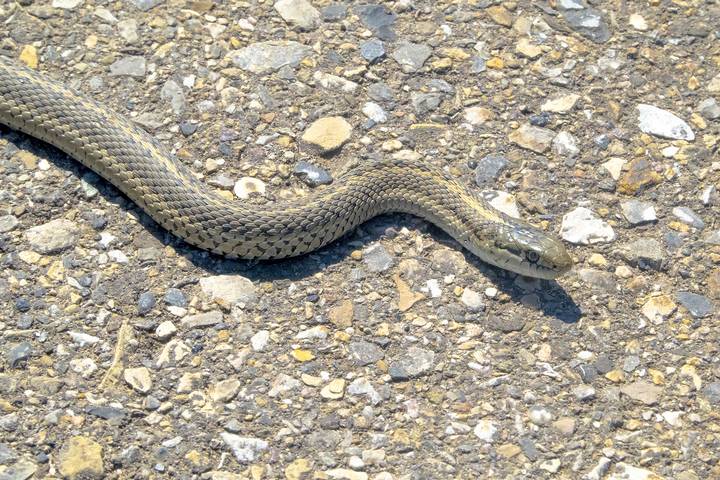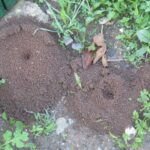
Garter snakes, often called garden snakes, are non-venomous reptiles frequently seen throughout North America. These fascinating creatures serve as vital predators in the ecosystem, primarily feasting on insects, slugs, tiny rodents, and amphibians. Garter snakes capture attention with their distinct appearance, featuring long, slender bodies adorned with stripes or patterns on their backs.
Although garter snakes pose no threat, they can sometimes bother humans. Some individuals might possess a deep-seated fear or aversion to snakes, leading to anxiety or unease when encountering these reptiles. Moreover, garter snakes may shelter in or around residential areas, causing worry or inconvenience. Despite these concerns, it’s crucial to remember that garter snakes contribute positively to pest control and play an integral part in the natural ecosystem.
Should you stumble upon garter snakes on your property and wish to remove them, it’s vital to ensure their well-being by using humane relocation methods. Destroying garter snakes is unwarranted and frowned upon since they’re innocuous and offer ecological advantages. As an alternative, use tactics to discourage their presence or transform the surroundings into a less inviting habitat for them.
Let’s learn how to get rid of garter snakes without killing them.
Seal entry points.
Securing entry points is vital to stop garter snakes from infiltrating your property. These slithery creatures can enter through tiny gaps or fissures in walls, foundations, or other apertures around your home or garden. By pinpointing and sealing these access points, you’ll effectively barricade their entry and dissuade their presence.
Employ suitable materials like caulk, weatherstripping, or wire mesh to close gaps and nooks that snakes could exploit as entrances. Keep a keen eye on spots surrounding doors, windows, utility pipes, and vents, as these are frequent entry points for serpents.
Closing off entry points prevents garter snakes from accessing your home. By minimizing possible openings, you’ll also deter other unwelcome critters and diminish water leaks or drafts. Make it a habit to regularly examine your property for gaps or holes and fix them as soon as possible to create a safer environment for snakes.
Remove hiding spots.
Eliminating hideaways discourages garter snakes from living on your property. These serpents seek shelter in protected spots like thick foliage, debris heaps, timber stacks, or tall grass. By eradicating these hideaways, you establish a less enticing environment for snakes and diminish their likelihood of settling in.
Removing brush, pruning overgrown greenery, and maintaining a neat and orderly yard can disrupt the snakes’ habitat and render your property less appealing to them. Alongside clearing exterior hideaways, it’s vital to tackle potential indoor refuge areas too. Garter snakes may slither into cellars, crawlspaces, or other dim and hidden zones.
Make it a habit to examine these spaces and ensure they are uncluttered frequently, closed off from exterior entryways, and brightly lit. By curbing hiding spots inside and outside your home, you can render your property less alluring to garter snakes. That will coax them to search for alternative locations far from your residence.
Maintain a tidy yard.
To minimize garter snakes around your property, maintain a neat and organized yard. A well-cared-for outdoor space eliminates potential feeding grounds, hiding spots, and breeding areas for these slithery visitors.
Make a habit of regularly mowing the lawn, trimming vegetation, and clearing away fallen leaves or debris. Establishing an open and immaculate landscape reduces garter snakes overstaying their welcome.
Snake fencing comprises impenetrable barriers below and above the ground, forming a tangible obstruction that snakes struggle to breach. Fences should be constructed with materials that snakes find challenging to scale or tunnel under, such as sleek metal or robust mesh.
Install snake fencing.
Snake fencing comprises impenetrable barriers that reach both below and above the ground, forming a tangible obstruction that snakes struggle to breach. Fences ought to be constructed with materials that snakes will find difficult to scale or tunnel under, such as sleek metal or robust mesh.
While installing snake fencing, it is crucial to ensure that the barriers are correctly set up and devoid of any gaps or apertures that snakes may exploit. The fence must be submerged deep enough to deter snakes from digging beneath it and high enough to dissuade them from climbing over it. Also, frequent fencing maintenance is essential to tackle wear and tear, confirming its efficiency in excluding garter snakes.
Use snake repellents.
Utilizing snake repellents can discourage garter snakes from invading your property. These repellents are generally made with natural ingredients or chemicals that produce smells or flavours that snakes find distasteful. Applying these repellents to specific spots or along the perimeter can establish a defensive barrier to keep snakes at bay.
Common snake-repellent choices include sulphur, cinnamon oil, clove oil, or naphthalene. These substances can easily be sprinkled or sprayed in desired locations. It’s essential to adhere to manufacturer guidelines and use snake-specific repellents. Frequent reapplication of repellents may be required, particularly after rain or when the scent or flavour fades with time.
Although snake repellents can be handy, it’s crucial to recognize that their efficacy might differ, and they may not assure total freedom from snakes. Snakes have diverse preferences and reactions. As a result, it’s suggested to merge snake-repellent usage with other preventive actions, such as sealing access points or eliminating hiding spaces, to boost their overall effectiveness.
Create snake-free zones.
Establishing snake-free areas on your property can offer security and tranquillity. A snake-free area is a space where you implement specific actions to reduce garter snakes. You can achieve this by employing a mix of techniques, such as altering the landscape, installing barriers, and removing features that attract snakes.
To develop a snake-free zone, modify the landscape to make snakes unwelcome. Clear dense foliage, high grass, and debris could serve as hiding places or offer cover. Design open and aesthetically pleasing spaces that snakes will find less enticing.
Consider putting up physical barriers like snake fencing or other barricades that hinder snakes from reaching certain regions. By establishing physical obstructions, you can limit snake mobility and access to designated zones within your property.
Additionally, pinpoint and eliminate elements that lure snakes. This can involve removing food sources such as rodent populations or bird feeders, which draw in small prey that snakes consume. Maintain elevated and tidy wood piles to minimize snake refuges.
Seek professional assistance if needed.
Should you find yourself grappling with ongoing garter snake challenges and feel uncertain about tackling the issue effectively, it would be prudent to enlist the help of a professional.
Skilled snake removal services or pest control specialists possess the know-how and finesse to evaluate the situation, pinpoint the factors that draw snakes in and offer suitable remedies. Utilizing safe and humane techniques, they address snake concerns while caring for human and reptile welfare.
Acquiring professional help can prove especially valuable in cases where you’re confronted with a substantial infestation or when snakes pose an immediate threat to your property or personal safety. These experts demonstrate their prowess by undertaking exhaustive examinations and devising custom strategies catered to your circumstances.












